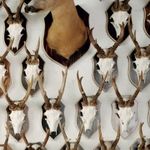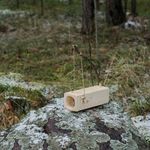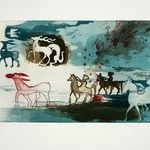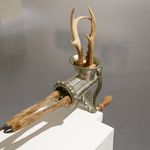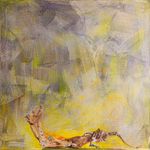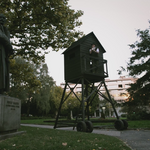Hunting Narratives
Hunting Narratives
UGM Studio, Trg Leona Štuklja 2, Maribor
Opening: Friday, 11 March 2016 at 19.00
Animals and hunting have always been a part of human life. Because of its involvement with the basic instincts of survival and their inherently strong emotions, hunting holds an important position in the collective subconscious.
The exhibition Hunting Narratives is merely a partial display of the integration of hunting into contemporary art formation. The works and approaches of artists are diverse and the discussed topics involve expressing emotions, historical research, symbolic content, and social criticism among other things. Conveying the message through "hunting material", the presence of animals, trophies, animal parts, and hunting customs are the common denominator of all exhibited works.
Compared to the past, relationships toward wild animals and hunting have been changing throughout modern times. Once the hunt was conducted for survival − wild animals provided food and other raw material; at the present, hunting is an industry regulated by law.
People have depicted animals and hunting since prehistoric times for various reasons: mostly for admiration, plot or hunting preparation, and demonstration of the hunt or killing the animal. The method of hunting, hunting techniques accessories, hunting habits and customs on how to utilise the animals killed, hunting cuisine, and also visual, musical, and literary hunting art are an important part of the folk tradition and the cultural heritage of hunting. Often, they are a feature of both small and large regions.
Ever since, body parts of respectfully killed animals or entire animals have represented a trophy for hunters, recognition and an award for a successful hunt. Trophies preserve the memory of the hunting merits for hunters; they prepare, collect and preserve them thoroughly. Some trophies are especially treasured, either because of the danger, rarity, size, or difficulty of killing these animals. Many animals were accorded a prominent position in folktales and popular beliefs that were handed down from generation to generation to became part of the national symbolism, culture, and identity.
Contemporary artists are fully aware of the hunting tradition, yet many of them are critical of hunting as a method of killing animals, especially because hunting is no longer conducted for survival but too often, in order to collect trophies.
Mito Gegič respects his family's hunting tradition, but does not adopt it as his own. He is very critical of it and the unnecessary killing of wildlife. He combines his paintings with digital media and processes them. In his non-painting works, he expands his critique to other fields of human activity and to the entire society.
The series Kapital by the art collective Irwin is not expressing its contradiction towards hunting and killing wild animals, but accentuating Slovenian traditions, iconography, and national symbols (sewer, stag, and cup of coffee) as well as the artistic avant-garde (Malevich's cross). The painted images in the gallery set-up are combined with depictions of popular folk images, stuffed, mounted animals and hunting trophies as another part of Slovenian tradition. The collective overtakes the artworks, reproduces them, and places them in new contexts.
In his series of conceptual photographs, Uroš Acman focuses on hunters' residences. Hunting cabins are museums of personal hunting history in which hunters keep their trophies as souvenirs of hunting events and simultaneously as proof of the hunter's, currently quite popular, being in-touch with nature. However, a hunting cabin also inadvertently resembles an animal graveyard.
In the series Evoked Past / Trap, Aljaž Celarc points out the Slovenian hunting and trapping traditions. He shows the past on photographs from the ethnological museum − old hunting traps for animals, also dormice, and reconstructs some of the traps from the photographs. For Celarc, the photographic camera also represents a trap with which he catches images of modern times that will be the past in future.
Jasmina Cibic prepared and documented on video the international performance The Ambassadors, which involves elements of hunting tradition that knows no territorial boundaries. At a Maribor city square, where the General Maister Memorial commemorates the Fight for the Northern Slovene Border to Austria at the end of World War I and where a linden tree was planted on the occasion of Slovenia's declaration of independence, she engages Slovenian and Austrian horn blowers to collectively imitate stags' rutting from a mobile hunting hide and a nearby building. By employing hunting means and posing political questions, Cibic points out the role of such public monuments.
The museum experience is also incorporated into the works of Svetlana Jakimovska Rodić. Following the images of Iron Age situlae, she graphically depicts the world of hunters, hunt, and also wildlife that peacefully lives in an idyllic and unspoiled nature. She points out the differences related to modern times.
Andrej Brumen Čop is straightforward; he depicts wild animal carcasses. He manages to transmit to the observer impressions and feelings of his encounters with the animal carcasses via paintings and evoke comparisons with the human world, estrangement in human society and the loneliness of the individual.
Wild animals painted by Mitja Ficko often have a symbolic meaning. Ficko frequently performs some kind of passage, as between the real and the spiritual or fictional, between civilisation and wilderness, the urban and nature, the known and the unknown. Beyond the passage, in the unknown, rests a symbolic animal.
Vladimir Leben in a humorous and somewhat ironic way shows the life of hunters, hunting dogs and wild animals. He draws attention to environmental issues and inhumane attitude towards animals, since the man is exploiting, abusing, threatening extinct animals and their habitat.
Essentially, the world of wildlife and hunting symbolically represents the human world. It is a critique of modern society, its values and desires, especially the desire of supremacy, conquest, and subordination. The exhibited works focus on the problems of modern times, such as consumerism, alienation, and lack of compassion and concurrently communicates that good has been nevertheless preserved and has to be continuously nurtured.
Exhibition curator: Denis Volk
Artists: Uroš Acman, Andrej Brumen Čop, Aljaž Celarc, Jasmina Cibic, Mitja Ficko, Mito Gegič, Svetlana Jakimovska Rodić, Vladimir Leben, skupina Irwin
YOU ARE KINDLY INVITED!
Protest letter regarding the exhibition Hunting Narratives (in Slovenian)
Supported by:




